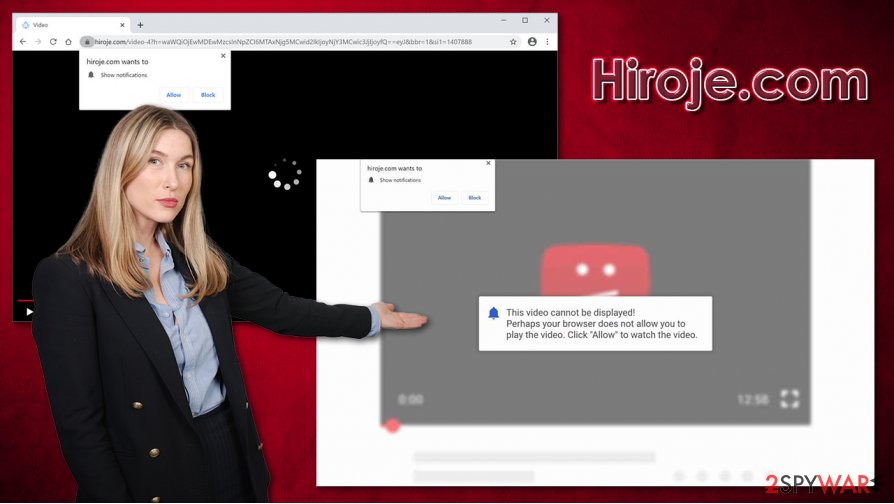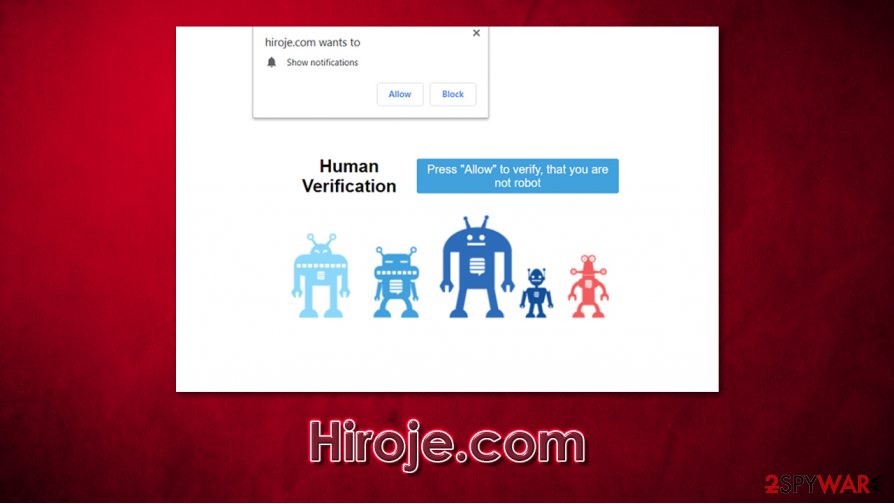Hiroje.com (Removal Guide) - Chrome, Firefox, IE, Edge
Hiroje.com Removal Guide
What is Hiroje.com?
Hiroje.com is a push notification virus that shows ads directly on a desktop

Hiroje.com is a scam website that can be encountered after being redirected from another suspicious site or after clicking on a deceptive link. Visitors are immediately presented with a deceptive claim, such as that they need to confirm that they are not a robot by clicking allow, and a push notification prompt is shown. This way, users subscribe to notifications that they never wanted in the first place.
If you pressed “Accept,” Hiroje.com popups will be shown at any time, regardless if Google Chrome, Mozilla Firefox, Safari, or another web browser is in operation. These ads are typically of a dubious content, as they promote fake security software, scam stories, clickbait,[1] and other things that should be not ever touched by users who value their online safety and computer security.
In case you encounter redirects Hiroje.com or similar malicious sites regularly, security experts advise checking the device for adware – a type of potentially unwanted program that specializes in showing intrusive ads, tracking their online activities, and monetizing their ad clicks or downloads.
| Name | Hiroje.com |
| Type | Push notification virus, scam |
| Infiltration | Website authors use various tricks to make users enable notifications to be shown. In particular, the injection of popups begins after the “Allow” button is pressed |
| Symptoms | Users start seeing popups on their desktops at any time when the machine is turned on |
| Dangers | Initially, allowing notifications through the site is not dangerous. However, clicking links and exploring the content that the website pushes can be extremely dangerous, and result in financial losses, personal information disclosure to cybercriminals, as well as malware infection |
| Elimination | To prevent the site from displaying notifications to you, access the site permission section via your web browser settings – you can find more details below |
| Additional steps | Redirects and ads might indicate adware infection, so you should check your system with anti-malware (e.g., SpyHunter 5Combo Cleaner, Malwarebytes), reset the installed web browsers, and attempt to fix virus damage with a repair tool FortectIntego |
Hiroje.com uses a very typical social engineering trick that abuses the legitimate push notification browser feature. Initially, it was developed by Google in 2012, and, since then, most of the other modern web browsers have adapted. Push notifications were meant to make content delivery for users who are interested in it much easier. For example, if you access YouTube, it may ask you to display notifications to inform you about new videos from your subscription list.
However, the feature was very quickly adopted by malicious actors who saw an opportunity to make a quick buck, and sites like Etnessbr.pro, Mpaxgrees.club, Thewowfeed.com, 7mono.biz, and many others, emerged. Developers of such websites do not care about users or their interests, as the only thing that matters is to scam them, only to later profit from ad revenue.
As soon as you access the Hiroje.com scam site, you will be presented with an image, typically followed by a short notification. There are several themes that these type of websites go by, the most commonly used ones include:
This video cannot be displayed! Perhaps your browser does not allow you play the video. Click “Allow” to watch the video.
Human verification
Press “Allow to verify, that you are not a robot
As evident, the actors behind Hiroje.com attempt to use pictures, prompts and other familiar attributes to make users press “Allow.” However, those who proceed with the request will soon see that there is no underlying content to be shown and that they get redirected to the same page. While most simply close down the site at this point, they do not immediately realize that they accepted notification prompts to be pushed.
The real danger of the so-called Hiroje.com virus lies within the content that users are presented with, as these are often malicious. In other words, the site uses scam techniques to make users subscribe to these ads, and then display ads that are less than secure to obtain monetary gain. In the meantime, users might be tricked into investing in fake money earning schemes, providing their credit card details, or installing bogus/malicious software on their system.

Even those who want to remove Hiroje.com from their systems are commonly unaware of how to do so. This is because the popups typically show up on the desktop, and there is no indication that web browser settings should be accessed in order to stop the activity once and for all.
We explain how to perform a complete Hiroje.com removal of notifications below. Nonetheless, if you click on ads, provided your passwords, or downloaded unknown programs from unknown websites, we advise you check your machine more thoroughly, i.e., scan it with anti-malware and repair tools (we recommend FortectIntego for the purpose), reset the installed web browsers and change your passwords for all your accounts.
Social engineering tricks you should familiarize yourself with
Fraud has been around for many years before the internet came into existence, so there is no surprise that the practice took off relatively quickly in the virtual sphere as well. And while security researchers and giant tech companies are trying to make the internet more secure with each passing year by implementing new security measures, online scams and phishing attempts are relatively common – they cost millions of dollars to users each year.
There are several techniques that threat actors use. Here are a few of the most commonly-used practices that result in monetary losses, malware infections, and other damages to users:
- Fake Flash Player updates. These fake popups typically claim that your Flash is out of date or missing, and needs to be installed to view the content. Fake Flash prompts are among the most commonly encountered threats on the internet, especially when it comes to Macs;[2]
- Software bundles. Third-party websites offer freeware that is bundled with questionable software – avoid unwanted programs by selecting Advanced settings instead of Recommended ones and decline all the offers on the way;
- Push notifications. As mentioned above, this seemingly useful browser feature is often abused by various websites in order to inject ads into users' desktops.
There are many more ways of how threat actors reach their malicious goals, so you should stay extremely careful when installing new programs, visiting websites, or checking your email. Ensure that you have powerful security software installed on your machine at all times to reduce the possibility of malware infection even further.

Stop Hiroje.com notifications from being shown and check your system for malware
Let's make it clear: if you did not click on any links from push notifications and are only looking for Hiroje.com removal options, your machine should be relatively safe and not infected with PUPs or malware. Cybercriminals abuse the fact that users are unfamiliar with this browser behavior, and that is why they struggle to eliminate popups once they click “Allow” on a suspicious website.
Here's how to remove Hiroje.com site from the allowed list on your browser:
Google Chrome
- Pick Menu > Settings > Advanced
- Go to Site Settings > Notifications
- Check the Allow section and find the site address
- Select More Actions and pick Block
Mozilla Firefox:
- Go to Menu > Options
- Choose Privacy & Security > Notifications > Settings
- Locate the suspicious URL, click on the the drop-down menu and select Block
- Save Changes to finalize
MS Edge (Chromium)
- Go to Menu > Settings
- Pick Site permissions
- Select Notifications
- Find the suspicious website, and click More actions
- Pick Block.
However, if you noticed that browser redirects are frequent, ads are shown on every website that you visit, it would also be beneficial to check your device for adware. You can either use our manual removal guide below or perform a full system scan with powerful anti-malware that would delete all the malicious components automatically.
Note: you can reset your web browsers to stop all sites, including Hiroje.com, to show you notifications. This would also delete cookies that are set on your browser to track your online activities.[3]
You may remove virus damage with a help of FortectIntego. SpyHunter 5Combo Cleaner and Malwarebytes are recommended to detect potentially unwanted programs and viruses with all their files and registry entries that are related to them.
Getting rid of Hiroje.com. Follow these steps
Uninstall from Windows
To get rid of unwanted programs on Windows, follow these steps:
Instructions for Windows 10/8 machines:
- Enter Control Panel into Windows search box and hit Enter or click on the search result.
- Under Programs, select Uninstall a program.

- From the list, find the entry of the suspicious program.
- Right-click on the application and select Uninstall.
- If User Account Control shows up, click Yes.
- Wait till uninstallation process is complete and click OK.

If you are Windows 7/XP user, proceed with the following instructions:
- Click on Windows Start > Control Panel located on the right pane (if you are Windows XP user, click on Add/Remove Programs).
- In Control Panel, select Programs > Uninstall a program.

- Pick the unwanted application by clicking on it once.
- At the top, click Uninstall/Change.
- In the confirmation prompt, pick Yes.
- Click OK once the removal process is finished.
Delete from macOS
Remove items from Applications folder:
- From the menu bar, select Go > Applications.
- In the Applications folder, look for all related entries.
- Click on the app and drag it to Trash (or right-click and pick Move to Trash)

To fully remove an unwanted app, you need to access Application Support, LaunchAgents, and LaunchDaemons folders and delete relevant files:
- Select Go > Go to Folder.
- Enter /Library/Application Support and click Go or press Enter.
- In the Application Support folder, look for any dubious entries and then delete them.
- Now enter /Library/LaunchAgents and /Library/LaunchDaemons folders the same way and terminate all the related .plist files.

Remove from Microsoft Edge
Delete unwanted extensions from MS Edge:
- Select Menu (three horizontal dots at the top-right of the browser window) and pick Extensions.
- From the list, pick the extension and click on the Gear icon.
- Click on Uninstall at the bottom.

Clear cookies and other browser data:
- Click on the Menu (three horizontal dots at the top-right of the browser window) and select Privacy & security.
- Under Clear browsing data, pick Choose what to clear.
- Select everything (apart from passwords, although you might want to include Media licenses as well, if applicable) and click on Clear.

Restore new tab and homepage settings:
- Click the menu icon and choose Settings.
- Then find On startup section.
- Click Disable if you found any suspicious domain.
Reset MS Edge if the above steps did not work:
- Press on Ctrl + Shift + Esc to open Task Manager.
- Click on More details arrow at the bottom of the window.
- Select Details tab.
- Now scroll down and locate every entry with Microsoft Edge name in it. Right-click on each of them and select End Task to stop MS Edge from running.

If this solution failed to help you, you need to use an advanced Edge reset method. Note that you need to backup your data before proceeding.
- Find the following folder on your computer: C:\\Users\\%username%\\AppData\\Local\\Packages\\Microsoft.MicrosoftEdge_8wekyb3d8bbwe.
- Press Ctrl + A on your keyboard to select all folders.
- Right-click on them and pick Delete

- Now right-click on the Start button and pick Windows PowerShell (Admin).
- When the new window opens, copy and paste the following command, and then press Enter:
Get-AppXPackage -AllUsers -Name Microsoft.MicrosoftEdge | Foreach {Add-AppxPackage -DisableDevelopmentMode -Register “$($_.InstallLocation)\\AppXManifest.xml” -Verbose

Instructions for Chromium-based Edge
Delete extensions from MS Edge (Chromium):
- Open Edge and click select Settings > Extensions.
- Delete unwanted extensions by clicking Remove.

Clear cache and site data:
- Click on Menu and go to Settings.
- Select Privacy, search and services.
- Under Clear browsing data, pick Choose what to clear.
- Under Time range, pick All time.
- Select Clear now.

Reset Chromium-based MS Edge:
- Click on Menu and select Settings.
- On the left side, pick Reset settings.
- Select Restore settings to their default values.
- Confirm with Reset.

Remove from Mozilla Firefox (FF)
If you are unable to uninstall extensions on Mozilla Firefox for some reason, you can get rid of the unwanted add-ons by resetting the web browser as explained below:
Remove dangerous extensions:
- Open Mozilla Firefox browser and click on the Menu (three horizontal lines at the top-right of the window).
- Select Add-ons.
- In here, select unwanted plugin and click Remove.

Reset the homepage:
- Click three horizontal lines at the top right corner to open the menu.
- Choose Options.
- Under Home options, enter your preferred site that will open every time you newly open the Mozilla Firefox.
Clear cookies and site data:
- Click Menu and pick Settings.
- Go to Privacy & Security section.
- Scroll down to locate Cookies and Site Data.
- Click on Clear Data…
- Select Cookies and Site Data, as well as Cached Web Content and press Clear.

Reset Mozilla Firefox
If clearing the browser as explained above did not help, reset Mozilla Firefox:
- Open Mozilla Firefox browser and click the Menu.
- Go to Help and then choose Troubleshooting Information.

- Under Give Firefox a tune up section, click on Refresh Firefox…
- Once the pop-up shows up, confirm the action by pressing on Refresh Firefox.

Remove from Google Chrome
Delete malicious extensions from Google Chrome:
- Open Google Chrome, click on the Menu (three vertical dots at the top-right corner) and select More tools > Extensions.
- In the newly opened window, you will see all the installed extensions. Uninstall all the suspicious plugins that might be related to the unwanted program by clicking Remove.

Clear cache and web data from Chrome:
- Click on Menu and pick Settings.
- Under Privacy and security, select Clear browsing data.
- Select Browsing history, Cookies and other site data, as well as Cached images and files.
- Click Clear data.

Change your homepage:
- Click menu and choose Settings.
- Look for a suspicious site in the On startup section.
- Click on Open a specific or set of pages and click on three dots to find the Remove option.
Reset Google Chrome:
If the previous methods did not help you, reset Google Chrome to eliminate all the unwanted components:
- Click on Menu and select Settings.
- In the Settings, scroll down and click Advanced.
- Scroll down and locate Reset and clean up section.
- Now click Restore settings to their original defaults.
- Confirm with Reset settings.

Delete from Safari
Remove unwanted extensions from Safari:
- Click Safari > Preferences…
- In the new window, pick Extensions.
- Select the unwanted extension and select Uninstall.

Clear cookies and other website data from Safari:
- Click Safari > Clear History…
- From the drop-down menu under Clear, pick all history.
- Confirm with Clear History.

Reset Safari if the above-mentioned steps did not help you:
- Click Safari > Preferences…
- Go to Advanced tab.
- Tick the Show Develop menu in menu bar.
- From the menu bar, click Develop, and then select Empty Caches.

After uninstalling this potentially unwanted program (PUP) and fixing each of your web browsers, we recommend you to scan your PC system with a reputable anti-spyware. This will help you to get rid of Hiroje.com registry traces and will also identify related parasites or possible malware infections on your computer. For that you can use our top-rated malware remover: FortectIntego, SpyHunter 5Combo Cleaner or Malwarebytes.
How to prevent from getting adware
Stream videos without limitations, no matter where you are
There are multiple parties that could find out almost anything about you by checking your online activity. While this is highly unlikely, advertisers and tech companies are constantly tracking you online. The first step to privacy should be a secure browser that focuses on tracker reduction to a minimum.
Even if you employ a secure browser, you will not be able to access websites that are restricted due to local government laws or other reasons. In other words, you may not be able to stream Disney+ or US-based Netflix in some countries. To bypass these restrictions, you can employ a powerful Private Internet Access VPN, which provides dedicated servers for torrenting and streaming, not slowing you down in the process.
Data backups are important – recover your lost files
Ransomware is one of the biggest threats to personal data. Once it is executed on a machine, it launches a sophisticated encryption algorithm that locks all your files, although it does not destroy them. The most common misconception is that anti-malware software can return files to their previous states. This is not true, however, and data remains locked after the malicious payload is deleted.
While regular data backups are the only secure method to recover your files after a ransomware attack, tools such as Data Recovery Pro can also be effective and restore at least some of your lost data.
- ^ Clickbait. Wikipedia. The free encyclopedia.
- ^ Lucian Armasu. Kaspersky: Fake Flash Updates Are Macs' Biggest Malware Threat. Tom's Hardware. Tech website.
- ^ What is online tracking and how do websites track you?. Koofr. Blog post.























